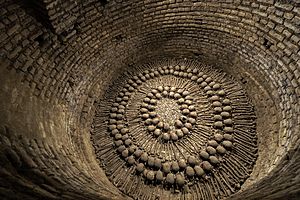Catacombs of Lima facts for kids
| Catacumbas de Lima | |

Human remains in the catacombs
|
|
| Established | c. 1600 |
|---|---|
| Location | San Francisco Convent, Lima, Peru |
| Type | Historic site |
| Collections | Ossuary contents of Lima's viceregal catacombs |
The Catacombs of Lima (Spanish: Catacumbas de Lima) are amazing underground tunnels and rooms in the old part of Lima, Peru. These special places are called ossuaries because they hold many human bones. They are built right under the famous San Francisco Convent. Today, these catacombs are a popular museum where visitors can learn about Lima's past.
Contents
History of Lima's Underground World
Building the Catacombs
The Franciscan order started building the San Francisco Convent in Lima around 1546. As part of this big project, they also built the catacombs underground. These underground areas were designed to help support the convent, especially if there was an earthquake.
For many years, the catacombs were used as a cemetery. This was during the time when Peru was ruled by Spain, known as the Viceroyalty of Peru. People were buried here until 1810. It's believed that about 25,000 bodies were laid to rest in these underground spaces.
From Cemetery to Museum
After Peru became independent from Spain, a general named José de San Martín stopped the use of the catacombs as a cemetery. The area was then closed off. It stayed closed for a long time, finally reopening in 1950. That's when it became the museum we know today. The museum had to close again for a short time during the COVID-19 pandemic in Peru.
Exploring the Hidden Tunnels
The full size of this underground network is still a mystery. It's not just under the convent! These tunnels actually connect to other important buildings in Lima. Some tunnels lead to the Government Palace and the Legislative Palace. Others even go under the Rímac river to a place called the Alameda de los Descalzos. There were also tunnels leading to the Puente de Piedra bridge and the Casa de Aliaga.
In 1981, people tried to map out all the tunnels. They found that the total area was much larger than expected. Besides the tunnels connecting to other parts of the city, they found a hidden room. This room might have been used to store ammunition. Another idea is that it was linked to the Desamparados Church. Experts believe these tunnels were built to protect people and valuable items from piracy.
The San Francisco complex, including the catacombs, is a very important historical site. The historic centre of Lima was recognized by UNESCO as a World Heritage Site on December 9, 1988. This means it's a special place that needs to be protected for everyone.
Famous People Buried Here
Many people were buried in the Catacombs of Lima. Some of them were very important figures from Peru's history. Here are a few:
- Constantino de Vasconcellos
- Manuel de Oms, who was the 24th Viceroy of Peru
- García Sarmiento de Sotomayor, the 16th Viceroy of Peru
- Fr. Juan Gómez, who was the personal nurse of Francis Solanus
- Fr. Ramón y Tagle y Bracho, the son of a famous marquis
- Fr. Andrés Corso, who was born in Corsica and died in the convent in 1620
- Fr. José Francisco de Guadalupe Mojica, a Franciscan friar
See also
 In Spanish: Catacumbas de Lima para niños
In Spanish: Catacumbas de Lima para niños

